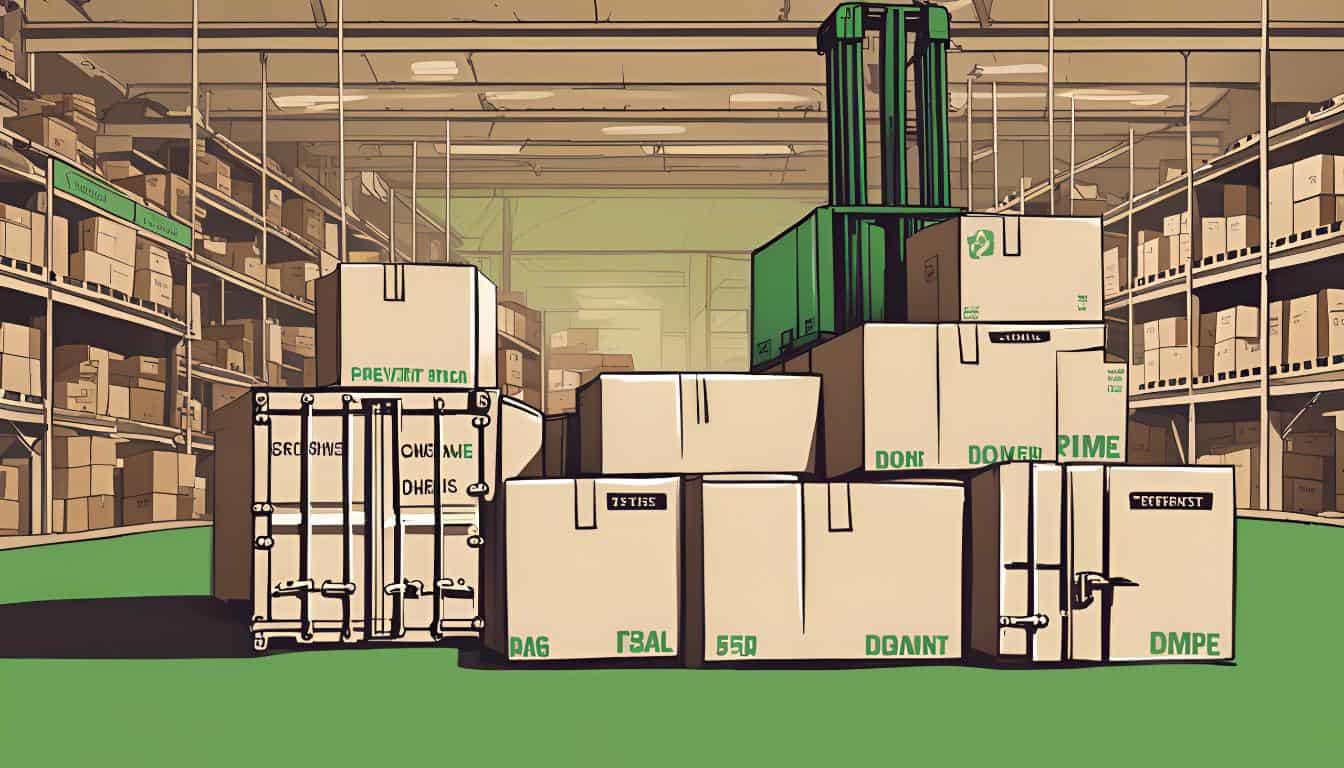Share this
Prevent Shipping Damage In 5 Simple Steps
by Shipfusion Team on Nov. 4, 2024

Speed is far from the only measure of success in shipping. Reliability – whether you’re talking about package handling or last-mile delivery to the right address – holds equal importance to customer satisfaction. Imagine putting so much work into building a robust ecommerce fulfillment system only to have that investment ruined by a careless carrier. Truly effective and sustainable logistics operations can only be achieved with proactive protections against shipping damage.
Plenty of things can be done upstream to ensure the integrity of parcels as they move from point to point in their journey. This article distills them into five simple steps and provides recommendations for what to do if and when shipping damage occurs.
Common Causes of Shipping Damage
Shipping damage is a costly and frustrating issue for ecommerce businesses, but it isn’t inevitable. Understanding common causes is the first step to meaningfully reducing risk.
Here are a few possibilities everyone should plan for:
Improper Packaging
One of the most prevalent causes of shipping damage is improper packaging. When products are not adequately protected, they are vulnerable to the rigors of transit. This includes using boxes that are too large or too small, failing to cushion items properly, or neglecting to wrap fragile items individually. For instance, a delicate glass vase shipped in a box without sufficient padding is likely to arrive shattered.
Ensuring that each item is securely packaged with appropriate materials is crucial to preventing damage. Moreover, the choice of packaging materials plays a significant role; using high-quality, durable boxes and cushioning materials can make a substantial difference in protecting your products. Consider investing in custom packaging solutions that fit your products perfectly, as this can minimize movement and provide better protection during transit.
Mishandling During Transit
Mishandling by carriers is another significant factor contributing to shipping damage. Packages are often subjected to rough handling, including drops, impacts, and stacking under heavy loads. This can lead to crushed boxes, broken items, and dissatisfied customers. While some degree of handling is inevitable, choosing carriers known for their careful handling practices can mitigate this risk.
"Fragile" and "handle with care" labels will alert handlers to take extra precautions. It’s also beneficial to establish a good relationship with your carriers, as this can lead to better service and more attention to detail when handling your shipments. Regularly reviewing carrier performance and seeking feedback can help you identify any issues and address them proactively.
Environmental Factors
Environmental factors such as temperature fluctuations, humidity, and exposure to moisture can also cause shipping damage. For example, electronics and perishable goods are particularly susceptible to damage from extreme temperatures. To combat this, businesses should consider using insulated packaging or moisture-resistant materials. Ensuring that packages are sealed properly can also prevent water damage during transit.
Monitoring weather conditions during shipping can also help you anticipate potential issues and take necessary precautions. For instance, if a shipment is traveling through an area experiencing extreme weather, you might choose to delay shipping or use specialized packaging to protect the contents.
Equipment Failures
Equipment failures, such as malfunctioning conveyor belts or forklifts, can lead to accidental damage during the shipping process. While these incidents are less common, they can still occur and result in significant losses. Regular maintenance and inspections of equipment used in warehouses and distribution centers can help prevent such failures.
Train employees on proper equipment usage and safety protocols to reduce the likelihood of accidents that lead to shipping damage. By fostering a culture of safety and responsibility, you can create a more reliable shipping process.
How to Prevent Shipping Damage
All of the precautions we’ve shared can substantially reduce the likelihood of shipping damage. However, there will always be some degree of risk. From filing claims with carriers to working with insurance companies and training customer service teams, each of the following steps can make all the difference in maintaining customer trust and minimizing financial losses if and when mishaps occur.
1. Choose the Right Packaging Materials
Choosing the right packaging materials is the first step in preventing shipping damage. Consider the size, weight, and fragility of the product when selecting packaging. Fragile items should be wrapped individually with bubble wrap or foam to provide extra protection. It's also important to choose the correct box size; a box that's too large can lead to movement and potential damage, while one that's too small may not provide adequate protection.
Additionally, using double-walled boxes for heavier items can offer extra strength and durability. To prevent water damage, use waterproof materials or seal packages with moisture-resistant tape. Filling empty spaces with packing peanuts or air pillows can further cushion items and prevent movement.
Testing your packaging by simulating shipping conditions can help identify potential weaknesses and ensure your products are well-protected. Consider conducting drop tests to see how your packaging holds up under various conditions, which can provide valuable insights into its effectiveness.
2. Use Proper Labeling
Proper labeling is essential in reducing the chance of rough handling. Labels such as "fragile" and "handle with care" can alert handlers to treat packages with extra caution. Ensure that shipping labels are placed in visible areas where they won't be overlooked or obscured by other markings. This simple step can make a significant difference in how packages are handled during transit.
Additionally, consider using color-coded labels to indicate the level of care required for different types of products. For example, a bright red label could signify that an item is extremely fragile, while a yellow label might indicate that it requires careful handling. This visual cue can help ensure that packages are treated appropriately throughout the shipping process.
3. Partner with Reliable Shipping Carriers
Partnering with reliable shipping carriers is crucial for minimizing shipping damage. Choose carriers that prioritize care and have a reputation for handling packages gently. Some carriers offer special handling services for fragile items, which can provide an added layer of protection. Additionally, investing in shipping insurance can mitigate the financial risk associated with damaged goods.
When selecting a carrier, consider their track record for on-time deliveries and damage claims. Reading reviews and seeking recommendations from other businesses can help you make an informed decision. Establishing clear communication with your carriers about your expectations and requirements can also foster a more collaborative relationship, leading to better service and fewer issues.
4. Use Advanced Tracking Systems
Advanced tracking systems can help prevent shipping damage by providing real-time updates on the location and condition of packages. These systems allow businesses to monitor shipments closely and address any issues that arise during transit. By staying informed, you can take proactive measures to prevent damage and ensure timely delivery.
Implementing technology such as GPS tracking and IoT sensors can provide valuable insights into the shipping process, allowing you to identify potential problems before they escalate. Additionally, sharing tracking information with customers can enhance their experience by keeping them informed about their order status, which can also reduce anxiety related to shipping delays or issues.
5. Train and Educate Employees
Training and educating employees who pack and label packages is vital in preventing shipping damage. Employees should be well-versed in proper packaging techniques and understand the importance of using the correct materials. Regular training sessions can keep staff updated on best practices and help maintain high standards in packaging and shipping processes.
Consider implementing a mentorship program where experienced employees can guide newer staff members in proper techniques. Additionally, creating a culture of accountability where employees feel responsible for the quality of their work can lead to better outcomes. Encouraging feedback and open communication can also help identify areas for improvement in your shipping processes.
Who Is Responsible for Shipping Damage?
Determining responsibility for shipping damage can be complex, as it often involves both the company and the carrier. Generally, the liability for shipping damage depends on the terms of the shipping agreement and the point at which the damage occurred. If the damage happens before the carrier takes possession of the goods, the company may be held responsible.
Conversely, if the damage occurs during transit, the carrier may be liable. Understanding the specific terms outlined in your shipping contracts is essential, as these agreements often contain clauses that define liability and responsibilities. It's also important to keep detailed records of your shipping processes, as this documentation can be invaluable in resolving disputes.
It's important to understand the laws and regulations surrounding shipping damage. The Carmack Amendment, for example, governs liability for interstate shipments in the United States and outlines the responsibilities of carriers and shippers. Familiarizing yourself with these regulations can help you navigate disputes and ensure that liability is appropriately assigned.
What to Do When Shipping Damage Occurs
When shipping damage occurs, the first step is to file a claim with the shipping carrier. Most carriers have specific procedures for handling claims, which typically involve providing documentation of the damage, such as photos and a detailed description. It's important to file claims promptly, as there are often time limits for submitting them.
Keeping thorough records of shipments and any correspondence with carriers can support your claim and expedite the resolution process. Maintain a checklist of required documentation to streamline the claims process and ensure you have everything you need to support your case. Being proactive and organized can significantly improve your chances of a successful claim.
Work with Insurance Companies
If you have shipping insurance, working with your insurance company can help cover the costs associated with damaged goods. Insurance policies vary, so it's essential to understand the coverage terms and conditions. In some cases, insurance may cover the full value of the damaged items, while in others, it may only cover a portion.
Communicating with your insurance provider and providing all necessary documentation can facilitate a smooth claims process. Additionally, reviewing your insurance policy regularly can help ensure that you have adequate coverage for your shipping needs, especially as your business grows and evolves.
Train Your Customer Service Team
Training your customer service team to handle shipping damage complaints effectively is crucial for maintaining customer satisfaction. Empower your team to address issues promptly and empathetically, offering solutions such as replacements or refunds when appropriate. Providing excellent customer service can turn a negative experience into a positive one, reinforcing customer loyalty and trust in your brand.
Consider implementing a feedback loop where customer service representatives can share insights and common issues with the shipping process, allowing your business to continuously improve its practices. Additionally, equipping your team with the tools and resources they need to resolve issues efficiently can enhance their effectiveness and boost customer satisfaction.
Need Help Preventing Shipping Damage?
Although literally and figuratively out of your hands to a degree, shipping damage can be mitigated with the right strategies in place. Proactively selecting strong packaging and reliable carriers will give your parcels the best chance possible of arriving at their destination in pristine condition.
A great fulfillment partner won’t hurt, either. Shipfusion is the best 3PL in North America for ecommerce businesses in industries ranging from Consumer Packaged Goods (CPG) to skincare and cosmetics. You can trust our well-trained team to pack orders with 99.9% accuracy throughout the year – even on Black Friday and Cyber Monday. We happily accommodate special packaging for subscription boxes, branded kits, and B2B/wholesale shipments, and can even recommend ways to optimize it for cost savings.
Seize every opportunity that comes with rapid growth by choosing a 3PL dedicated to catering to you. Contact us today and a fulfillment specialist will provide you with a free, no-obligation quote.
Share this
You May Also Like
These Related Articles

What is Dunnage in Shipping? Using it to Improve Shipping Efficiency and Costs

Perks Of Custom eCommerce Shipping Boxes

A Brief Guide to Ecommerce Shipping
- April 2025 (18)
- March 2025 (26)
- February 2025 (26)
- January 2025 (37)
- December 2024 (16)
- November 2024 (23)
- October 2024 (22)
- September 2024 (27)
- August 2024 (9)
- July 2024 (8)
- June 2024 (5)
- May 2024 (8)
- April 2024 (8)
- March 2024 (6)
- February 2024 (6)
- January 2024 (5)
- December 2023 (3)
- November 2023 (3)
- October 2023 (5)
- September 2023 (4)
- August 2023 (2)
- July 2023 (1)
- June 2023 (4)
- March 2023 (2)
- October 2022 (1)
- September 2022 (5)
- August 2022 (4)
- July 2022 (7)
- June 2022 (4)
- May 2022 (4)
- April 2022 (6)
- March 2022 (2)
- February 2022 (1)
- January 2022 (3)
- December 2021 (2)
- November 2021 (4)
- October 2021 (2)
- September 2021 (5)
- August 2021 (4)
- July 2021 (4)
- June 2021 (3)
- May 2021 (2)
- April 2021 (3)
- March 2021 (3)
- February 2021 (3)
- January 2021 (2)
- December 2020 (4)
- November 2020 (2)
- October 2020 (4)
- September 2020 (2)
- July 2020 (5)
- June 2020 (4)
- May 2020 (2)
- April 2020 (2)
- March 2020 (4)
- February 2020 (1)
- December 2019 (1)
- May 2018 (1)
- March 2018 (2)
- February 2018 (3)
- January 2018 (3)
- November 2017 (3)
- July 2017 (4)
- March 2017 (3)
- February 2017 (5)
- January 2017 (3)
- December 2016 (4)
- November 2016 (6)
- October 2016 (6)
- October 2015 (1)
- September 2015 (1)
- June 2015 (3)
- May 2015 (3)
- August 2014 (1)
- July 2014 (1)
- March 2014 (1)
- February 2014 (1)